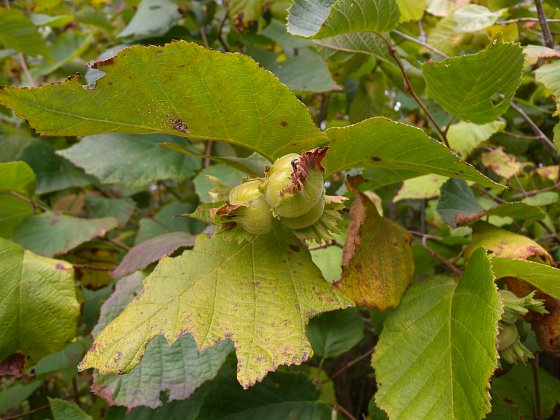Description: This shrub is 4-15' tall and abundantly branched. It is usually multi-stemmed at the base, but sometimes forms a small trunk. The bark is gray and smooth on young branches, becoming more rough on older branches and/or the trunk. Young twigs are brown and often covered with reddish brown hairs. The alternate leaves are up to 6" long and 4½" across; they are oval-ovate and doubly serrate. The upper surfaces of the leaves are medium green and hairless to mostly hairless, while their lower surfaces have stiff short hairs. The slender petioles are up to 1/3" (8 mm.) long and usually hairy. American Hazelnut is monoecious with male (staminate) and female (pistillate) flowers developing on the same shrub. These flowers develop near the tips of second-year branches. Immature male flowers are found on catkins during the fall, which persist through the winter; these catkins are narrowly cylindrical in shape. During early to middle spring, the male catkins become longer (about 2-4" in length) while drooping from their branches, and their flowers bloom. Each male flower on the catkin consists of a pair of tiny bracts and 4 stamens. The female flowers also bloom during early to middle spring. Several female flowers bloom together from a small swollen bud that is surrounded by protective bracts; only the red stigmata of the flowers are exerted beyond the bracts. Cross-pollination is achieved by wind.

After the blooming period, the male catkins turn brown and wither away, while fertile female flowers develop into a small cluster of nuts on short branches. Each nut is enclosed by two protective bracts that are initially light green, but later turn brown when the nuts are ripe. Usually, the outer surface of these bracts has fine silky hairs, otherwise it is glabrous. The wide outer margins of these bracts are deeply cleft into ragged lobes; they are appressed together. Each nut is about ½" across, globoid to subgloboid in shape, and slightly compressed; it is tan-colored at its apex and brown below. The woody root system is shallow and branching; it is also strongly rhizomatous, forming vegetative offsets. As a result, colonies of shrubs are often formed. During the fall, the deciduous leaves become yellowish green, orange, red, or purple.
Cultivation: This adaptable shrub prefers full sun to light shade, moist to dry-mesic conditions, and a variety of soil types, including those that are loamy, sandy, or rocky.
Range & Habitat: The native American Hazelnut has been found in all counties of Illinois (see Distribution Map); it is occasional to locally common throughout the state. However, populations of this shrub have declined somewhat because of habitat destruction. Habitats include rocky upland forests, moist to dry-mesic woodlands, sandy Oak woodlands, wooded slopes, woodland borders, typical thickets and sandy thickets, typical savannas and sandy savannas, moist to dry-mesic prairies and sand prairies, and fence rows. Sometimes this shrub is cultivated as a landscape plant.
thickets and sandy thickets, typical savannas and sandy savannas, moist to dry-mesic prairies and sand prairies, and fence rows. Sometimes this shrub is cultivated as a landscape plant.
Faunal Associations: Many insects feed on the leaves, nuts, plant sap, and other parts of American Hazelnut and other Hazelnut shrubs (Corylus spp.). They include leaf beetles, weevils, larvae of gall flies, plant bugs, aphids, leafhoppers, treehoppers, larvae of sawflies, larvae of many moths, and walkingstick insects. American Hazelnut is the preferred host plant of several leafhoppers (Eratoneura); it is also a host plant of the Luna Moth (Actias luna), one of the Giant Silk moths (Saturniidae). The Insect Table provides a more detailed list of these species. The nuts of American Hazelnut are eaten by such birds as the Blue Jay, Red-bellied Woodpecker, Hairy Woodpecker, Bobwhite Quail, Wild Turkey, Ring-necked Pheasant, and Ruffed Grouse. The latter bird species also feeds on the buds and catkins (DeGraaf, 2002; Martin et al., 1951/1961). Mammals that feed on the nuts of American Hazelnut and other Hazelnut shrubs include the White-footed Mouse, Deer Mouse, Raccoon, Eastern Chipmunk, Fox Squirrel, and probably Gray Squirrel. The White-tailed Deer feeds on the twigs during winter, while the American Beaver feeds on the wood and bark of these shrubs (Hamilton, 1941; Martin et al., 1951/1961). Because American Hazelnut is a leafy and densely branched shrub, it provides excellent protective cover for many kinds of wildlife, including the American Woodcock (DeGraaf, 2002).
Photographic Location: A moist sandy thicket at the Iroquois County Conservation Area in Illinois.
Comments: This interesting shrub has sweet edible nuts that can be eaten raw or used in cooking. They are high in protein and very nutritious. American Hazelnut is relatively easy to identify during the summer and fall because its nuts are surrounded by distinctive bracts with wide ragged margins. Another native shrub, Corylus cornuta (Beaked Hazelnut) is rare in Illinois; it has been found only in Jo Daviess county at the NW corner of the state. Beaked Hazelnut has less hairy leaf undersides, petioles, and twigs than American Hazelnut. The protective bracts of its nuts join together to form a long narrow beak that is very different from the bracts of American Hazelnut. Beaked Hazelnut is a boreal species that is more common in areas that lie to the north and northeast of Illinois. It is one of the food plants of the American Moose.